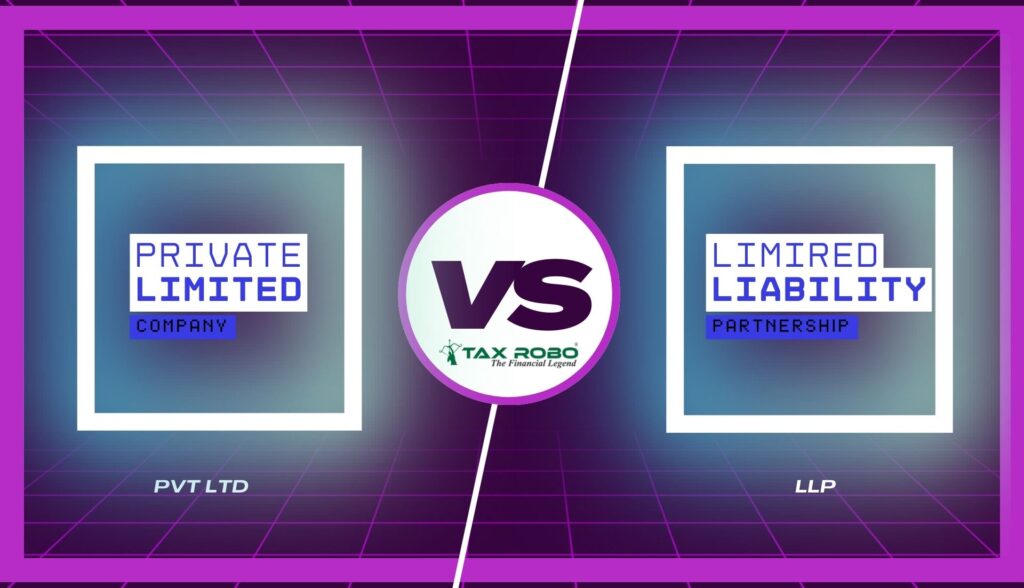When it comes to starting a business in India as a Non-Resident Indian (NRI), two popular business structures often come into consideration: the Private Limited Company (PLC) and the Limited Liability Partnership (LLP). Both offer distinct advantages and drawbacks, and selecting the right structure depends on various factors such as the nature of the business, ownership structure, and long-term goals. In this blog, we’ll compare these two options to help NRI entrepreneurs make an informed decision.
Features of Pvt Ltd Company
A Private Limited Company (PLC) is one of the most popular business structures in India, especially for NRI entrepreneurs. Here are some key features that make it an attractive option:
- Separate Legal Entity:
- A Private Limited Company has a separate legal identity from its owners (shareholders) and directors. This means the company can own assets, incur liabilities, and enter into contracts in its name, independent of its shareholders.
- Limited Liability:
- Shareholders in a Private Limited Company enjoy limited liability, meaning their personal assets are not at risk in case of business debts or liabilities. The liability of shareholders is limited to the unpaid amount on their shares.
- Flexible Ownership Structure:
- A PLC can have a minimum of two and a maximum of 200 shareholders. Shares can be freely transferred among the existing shareholders, and the ownership structure can be modified as needed.
- Perpetual Succession:
- The company continues to exist even if shareholders or directors change. The continuity of the business is not affected by the death or incapacity of any individual involved in the company.
- Ease of Raising Capital:
- A Private Limited Company can raise capital through the issuance of shares. This structure makes it easier to attract investors, including venture capitalists or private equity firms, which is crucial for business expansion.
- Tax Benefits:
- PLCs are subject to corporate tax rates, which may be more beneficial for some types of businesses. The tax structure also offers certain deductions and benefits, making it attractive for businesses planning to grow and reinvest profits.
- Ability to Attract Foreign Investment:
- A Private Limited Company can receive Foreign Direct Investment (FDI), making it an ideal choice for NRI entrepreneurs who are looking to attract international investors.
- Professional Management:
- Private Limited Companies often have a formal management structure with appointed directors, allowing for professional governance. This is beneficial for scalability and expanding the business operations.
- Exit Strategies:
- A Private Limited Company provides more flexible exit options, such as selling shares to other investors or partners, thereby offering a clear path for shareholders to exit or cash out.
LLP vs Pvt Ltd: Advantages and Disadvantages
When comparing LLP and Private Limited Company, each structure has its own set of advantages and disadvantages. Understanding these will help NRI entrepreneurs decide which option is best suited for their needs.
Private Limited Company (PLC) – Advantages
- Limited Liability Protection:
- The primary advantage of a PLC is the limited liability it offers to shareholders. Personal assets of the shareholders are protected from business liabilities and debts.
- Easier Access to Funding:
- PLCs are more attractive to investors, including venture capitalists and private equity firms. They can issue shares, which makes raising capital much easier than in an LLP.
- More Scalable Business Model:
- PLCs are better suited for businesses with growth potential. They can expand rapidly, raise funds through share issuance, and take on more investors as the business grows.
- Credibility and Professionalism:
- A PLC is often seen as more credible and professional due to its strict regulatory requirements and formal management structure. This can boost customer and investor confidence.
- Perpetual Succession:
- The company continues to exist even if shareholders or directors change, making it easier to transfer ownership or pass the business on to future generations.
Private Limited Company (PLC) – Disadvantages
- Higher Compliance Costs:
- PLCs are subject to stringent regulatory requirements, including regular audits, annual filings, and the maintenance of statutory records. This can incur higher compliance and administrative costs.
- Complex Ownership Transfer:
- While shares can be transferred, the process of ownership change may involve paperwork and approvals, which could be more complex than in an LLP.
- Double Taxation:
- PLCs are taxed as separate entities. This could result in double taxation, first on the company’s profits and again on dividends distributed to shareholders, which may not be ideal for smaller businesses.
- More Formalities in Management:
- A PLC requires more formalities in terms of board meetings, annual general meetings (AGMs), and other governance procedures. This can be time-consuming and administratively intensive.
Limited Liability Partnership (LLP) – Advantages
- Simplicity in Structure and Operations:
- LLPs are simpler to manage than a PLC. There are fewer compliance requirements, no mandatory audits, and the governance structure is more flexible.
- Pass-Through Taxation:
- An LLP is taxed at the partner level, meaning there is no corporate tax. This reduces the overall tax burden on the business and avoids double taxation (as in PLCs).
- Lower Compliance Costs:
- LLPs are subject to fewer regulations and therefore incur lower compliance and operational costs. There is no need for an annual audit unless the turnover exceeds a certain limit.
- Flexibility in Ownership and Management:
- LLPs provide flexibility in the ownership and management structure. Partners can decide how to distribute profits and manage the business through a partnership agreement.
- Limited Liability:
- Like PLCs, LLPs also offer limited liability protection to their partners. Personal assets are protected from business liabilities, making it a safer option for smaller businesses or professional services.
Limited Liability Partnership (LLP) – Disadvantages
- Limited Ability to Raise Capital:
- Unlike a PLC, an LLP cannot issue shares, making it difficult to raise funds from external investors. This limits growth potential compared to a PLC.
- No Option for Public Listing:
- An LLP cannot be listed on the stock exchange, which makes it less attractive for businesses looking to go public or raise significant capital in the future.
- Limited Scope for Expansion:
- LLPs are more suitable for small businesses and professional services but may face difficulties when trying to scale up or attract larger investments.
- Complex Exit Strategy:
- Exiting an LLP is more complicated than a PLC. There is no easy way to sell or transfer ownership to outsiders, and partners need to agree on terms before an exit is possible.
LLP vs Pvt Ltd: Registration Process
The process of registering a Private Limited Company (PLC) and a Limited Liability Partnership (LLP) in India involves several steps, but the complexity and required documentation differ. Here’s an overview of both:
Private Limited Company Registration Process
- Obtain Director Identification Number (DIN):
- Every director of the Private Limited Company must apply for a DIN, which is a unique identification number issued by the Ministry of Corporate Affairs (MCA).
- Obtain Digital Signature Certificate (DSC):
- A DSC is required for signing documents electronically, which is necessary for e-filing with the MCA. This is a mandatory step for directors or any signatories.
- Name Reservation:
- The company name must be approved by the MCA. You can propose up to two names and file them with the MCA using the RUN (Reserve Unique Name) service.
- Drafting the Memorandum and Articles of Association (MOA and AOA):
- The MOA and AOA define the objectives, scope, and governance rules of the company. These documents need to be drafted carefully.
- Filing with the MCA:
- Once the name is approved and the necessary documents are in place, the registration forms (SPICe Form) need to be submitted to the MCA for approval.
- Certificate of Incorporation:
- After the application is approved, the MCA will issue a Certificate of Incorporation, marking the legal existence of the company.
- PAN and TAN Application:
- Apply for a PAN (Permanent Account Number) and TAN (Tax Deduction and Collection Account Number) for the company. This is necessary for taxation and business operations.
- Opening a Bank Account:
- After incorporation, a company bank account must be opened using the Certificate of Incorporation, PAN, and other relevant documents.
Limited Liability Partnership (LLP) Registration Process
- Obtain Digital Signature Certificate (DSC):
- Similar to a PLC, the designated partners of the LLP must obtain a DSC for filing online documents with the MCA.
- Obtain Director Identification Number (DIN):
- Partners in the LLP must obtain a DIN. If the designated partners do not already have it, they must apply for it.
- Choose a Name:
- You need to choose an LLP name and apply to the MCA for approval. The name should be unique and comply with the guidelines set by the MCA.
- Filing Incorporation Documents:
- The incorporation documents, including the LLP Agreement and Form 2, need to be filed with the MCA. The LLP Agreement outlines the profit-sharing ratio and the roles of partners.
- LLP Registration:
- After reviewing the documents, the MCA will issue a Certificate of Incorporation, confirming the LLP’s formation.
- PAN and TAN Application:
- Just like a PLC, an LLP needs to apply for PAN and TAN for taxation and compliance purposes.
- Opening a Bank Account:
- Once the registration is complete, an LLP can open a business bank account using the incorporation certificate, PAN, and other documents.
LLP vs Pvt Ltd: Membership and Directors
One of the key differences between an LLP and a Private Limited Company is in their membership and the roles of directors/partners. Here’s a breakdown:
LLP vs Pvt Ltd FDI
Foreign Direct Investment (FDI) plays a vital role in the growth of businesses in India, especially for NRI entrepreneurs. However, the ability of a business structure to attract FDI varies between a Private Limited Company (PLC) and a Limited Liability Partnership (LLP). Here’s a comparison of how both structures fare with FDI:
Private Limited Company (PLC) and FDI
A Private Limited Company is well-equipped to accept Foreign Direct Investment (FDI), and it is one of the most preferred structures for foreign investors looking to invest in India. Under the FDI policy of the Government of India, a PLC can accept FDI through various routes, such as:
- Automatic Route:
- In most sectors, foreign investment up to 100% is allowed under the automatic route, meaning the business does not require prior approval from the Reserve Bank of India (RBI) or the government.
- Approval Route:
- Certain sectors, like defense, retail, and others, have restrictions on FDI. For these sectors, FDI can be allowed after obtaining government approval.
The ability to issue shares, along with the regulatory framework supporting FDI, makes the PLC the preferred structure for foreign investments in India.
Limited Liability Partnership (LLP) and FDI
While LLPs are generally more flexible and simpler to manage, they face limitations when it comes to attracting FDI. FDI in LLPs is allowed but subject to specific conditions:
- FDI in LLPs:
- Foreign investment in LLPs is permitted in sectors where 100% FDI is allowed under the automatic route. However, there are restrictions when it comes to foreign participation in certain sectors (such as agriculture or defense).
- Approval Requirement:
- For FDI in an LLP, prior approval from the government or RBI may be required in certain cases, and this makes it more complex compared to PLCs.
- Challenges for LLPs:
- LLPs cannot issue shares, which limits their ability to raise capital from foreign investors. This makes it harder for LLPs to attract large-scale foreign investment compared to Private Limited Companies.
If attracting FDI is a key consideration for an NRI entrepreneur, a Private Limited Company is generally the better choice due to its flexibility in accepting foreign investments and its ability to issue shares. An LLP, while offering certain advantages like simpler management and pass-through taxation, faces more limitations in terms of foreign funding opportunities.



